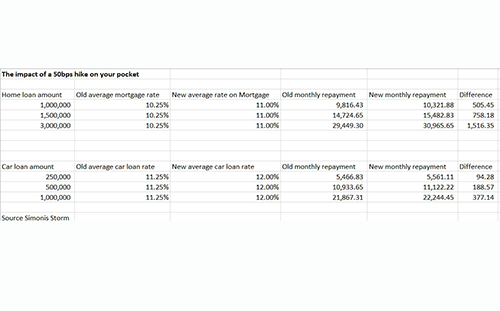As expected, the Bank of Namibia’s (BoN’s) Monetary Policy Committee (MPC) yesterday increased the repo rate by 75 basis points to 6.25%. The central bank stated that the decision was taken with due consideration of the persistent inflationary pressures, and they thus deemed it necessary to narrow the current negative real policy interest rate.
The BoN also noted that the decision is consistent with that taken around the globe and in the region, with policymakers acting with resolve to slow and eventually reverse the current inflation acceleration.
The domestic annual average inflation rate increased to 5.8% during the first nine months of 2022, compared to 3.5% in the corresponding period of 2021.
According to the BoN, the continued rise in inflation was predominantly driven by higher transport inflation on account of international oil prices that remained elevated. Overall inflation declined slightly to 7.1% during September 2022 from 7.3% registered in August 2022. The monthly decline was mainly attributed to a deceleration in transport inflation, owing mainly to a slowdown in the international oil price during September 2022.
“Namibia’s overall inflation for 2022 is now projected to average around 6.1%, up from 5.8% initially projected during the previous MPC meeting. The upward revision is mainly due to expected higher food inflation and a weaker exchange rate,” said BoN governor Johannes !Gawaxab.
He added that the central bank will continue monitoring local, regional and global developments and their potential effects on the domestic economy and will act appropriately, in line with its mandate to ensure price stability in the interest of sustainable economic growth and the development of the country.
Weighing in on this latest increase, economic analyst at Simonis Storm Theo Klein observed that the repo rate remains low relative to inflation in Namibia and South Africa, suggesting that monetary policy is accommodative at the moment.
“However, the gap is narrowing as rates rise, and we believe inflation has peaked in July 2022 in South Africa and August 2022 in Namibia. Going forward, we certainly expect inflation to come in lower during the remainder of 2022 and 2023 as well. This is mainly due to observing more global deflationary pressures, and the fact that inflation rates will be coming off a high base,” he stated.
Klein further cautioned that tight financial conditions for indebted Namibian households and corporates lie ahead as rate hikes are expected to rise further towards the end of this year and during the first quarter of 2023.
He said the risk of continuing with an aggressive rate hiking cycle in South Africa – and Namibia by implication – is that monetary policy becomes restrictive for an economy not experiencing demand-pull inflationary pressures and having numerous domestic economic growth challenges. This, he noted, implies the rate hiking cycle in South Africa – and Namibia – could come to an end by early 2023.
Said Klein: “Hence, we expect a 50bps repo rate hike in 1Q2023 in both South Africa and Namibia, followed by two consecutive 25bps cuts in the third and fourth quarters of 2023”.
Meanwhile, minutes from the recent United States’ central bank meeting indicated that “historical experience demonstrated the danger of prematurely ending periods of tight monetary policy designed to bring down inflation”. This, Klein pointed out, “supports the notion that although the rate hiking cycle might end in the first quarter of next year, interest rates globally and locally will likely remain at elevated levels for a while, before we see rate cuts taking place”.
Furthermore, the South African Reserve Bank’s (SARB’s) Quarterly Projection Model estimates a neutral rate of 6.75%, while other economists estimate between 7.25% and 7.50%.
“The neutral rate is theoretically the interest rate at which monetary policy is neither expansionary nor contractionary, keeping inflation constant. As the repo rate approaches the neutral rate, it could warrant the SARB to be more gradual in the pace of interest rate hikes, going forward,” he explained.


